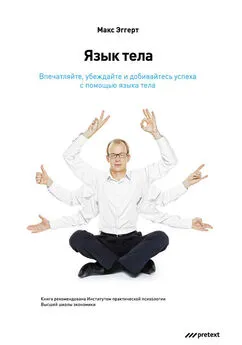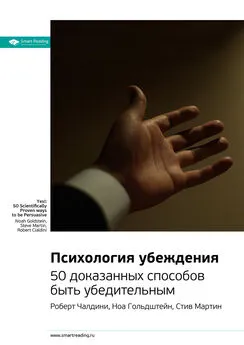Роберт Чалдини - Психология влияния. Как научиться убеждать и добиваться успеха
- Название:Психология влияния. Как научиться убеждать и добиваться успеха
- Автор:
- Жанр:
- Издательство:Питер
- Год:2014
- Город:СПб
- ISBN:978-5-496-01033-7
- Рейтинг:
- Избранное:Добавить в избранное
-
Отзывы:
-
Ваша оценка:
Роберт Чалдини - Психология влияния. Как научиться убеждать и добиваться успеха краткое содержание
«Психология влияния» — одно из лучших учебных пособий по социальной психологии, конфликтологии, менеджменту, по мнению большинства западных и отечественных психологов. Книга Роберта Чалдини выдержала в США пять изданий, ее тираж давно уже превысил два миллиона экземпляров. Эта работа, подкупающая читателя легким стилем и эффектной подачей материала, — серьезный труд, в котором на самом современном уровне анализируются механизмы мотивации, усвоения информации и принятия решений.
Новое, переработанное и дополненное, издание международного бестселлера займет достойное место в библиотеке психолога, менеджера, педагога, политика — каждого, кто по роду деятельности должен убеждать, воздействовать, оказывать влияние.
Психология влияния. Как научиться убеждать и добиваться успеха - читать онлайн бесплатно ознакомительный отрывок
Интервал:
Закладка:
Fazio, R.H., Blascovich, J., Driscoll, D. (1992). On the functional value of attitudes. Personality and Social Psychology Bulletin, 18, 388–401.
Fazio, R.H., Sherman, S.J., Herr, P.M. (1982). The feature-positive effect in the self-perception process. Journal of Personality and Social Psychology, 42, 404–411.
Feinberg, R.A. (1986). Credit cards as spending facilitating stimuli. Journal of Consumer Research, 13, 348–356.
Feinberg, R.A. (1990). The social nature of the classical conditioning phenomena in people. Psychological Reports, 67 , 331–334.
Fenigstein, A., Scheier, M.F., Buss, A.H. (1975). Public and private self-consciousness: Assessment and theory. Journal of Consulting and Clinical Psychology, 43 , 522–527.
Festinger, L. (1954). A theory of social comparison processes. Human Relations, 7 , 117–140.
Festinger, L. (1957). A theory of cognitive dissonance. Stanford: Stanford University Press.
Festinger, L., Riecken, H.W., Schachter, S. (1964). When prophecy fails. New York: Harper.
Fiske, S.T., Neuberg, S.L. (1990). A continuum of impression formation: Influences of information and motivation on attention and interpretation. In M.P. Zanna (Ed.), Advances in experimental social psychology (Vol. 23, pp. 1–74). New York: Academic Press.
Fleming, T. (1997, November 23). 13 things you never knew about the American Revolution. Parade, pp. 14–15.
Flynn, F.J. (2002). What have you done for me lately? Temporal adjustments to favor evaluations. Organizational Behavior and Human Decision Processes, 91 , 38–50.
For women, all’s pheromones in love, war. (1999, March 7). The Arizona Republic, p. E19.
Foster, E. (1991, January 28). Lobbyists circle over capitol. The Arizona Republic, pp. Ai, A6.
Foushee, M.C. (1984). Dyads and triads at 35,000 feet: Factors affecting group process and aircraft performance. American Psychologist, 39, 885–893.
Fox, M.W. (1974). Concepts in ethology: Animal and human behavior. Minneapolis: University of Minnesota Press.
Freedman, J.L. (1965). Long-term behavioral effects of cognitive dissonance. Journal of Experimental Social Psychology, 1, 145–155.
Freedman, J.L., Fraser, S.C. (1966). Compliance without pressure: The foot-in-the door technique. Journal of Personality and Social Psychology, 4, 195–203.
Frenzen, J.R., Davis, H.L. (1990). Purchasing behavior in embedded markets. Journal of Consumer Research, 17 , 1–12.
Fromkin, H. L, Brock, T.C. (1971). A commodity theory analysis of persuasion. Representative Research in Social Psychology, 2, 47–57.
Furnham, A. (1996). Factors relating to the allocation of medical resources. Journal of Social Behavior and Personality, 11, 615–624.
Gaertner, S.L., Dovidio, J.F., Rust, M. C, Neir, J.A., Banker, B.S., Ward, C.M., Mottola, G. R, Houlette, M. (1999). Reducing intergroup bias: Elements of intergroup cooperation. Journal of Personality and Social Psychology, 76, 388–402.
Ganzberg, M. (1964, March 27). New York Times, p.1.
Garner, R.L. (2005). What’s in a name? Persuasion perhaps? Journal of Consumer Psychology, 15 , 108–116.
Gawronski, B. (2003). Implicational schemata and the correspondence bias: On the diagnostic value of situationally constrained behavior. Journal of Personality and Social Psychology, 84, 1154–1171.
George, W.H., Gournic, S.J.,McAfee, M.P. (1988). Perceptions of postdrinking female sexuality. Journal of Applied Social Psychology, 18, 1295–1317.
Gerard, H.B., Mathewson, G.C. (1966). The effects of severity of initiation on liking for a group: A replication. Journal of Experimental Social Psychology, 2, 278–287.
Gergen, K., Ellsworth, P., Maslach, C., Seipel, M. (1975). Obligation, donor resources, and reactions to aid in three cultures. Journal of Personality and Social Psychology, 31, 390–400.
Gigerenzer, G., Goldstein, D.G. (1996). Reasoning the fast and frugal way: Models of bounded rationality. Psychological Review, 103 , 650–669.
Gilbert, D.T., Osborne, R.E. (1989). Thinking backward: Some curable and incurable consequences of cognitive business. Journal of Personality and Social Psychology, 57, 940–949.
Gleick, E. (1997, February 10). Marine blood sports. Time, p. 30.
Goldstein, N.J., Mortensen, C.R., Griskevicius, V., Cialdini, R.B. (January, 2007). I’ll scratch your back if you scratch my brother’s: The extended self and extradyadic reciprocity norms. Poster presented at the meeting of the Society of Personality and Social Psychology, Memphis, TN.
Gonzales, M.H., Davis, J.M., Loney, G.L., Lukens, C.K., Junghans, C.M. (1983). Interactional approach to interpersonal attraction. Journal of Personality and Social Psychology, 44, 1192–1197.
Goodenough, U.W. (1991). Deception by pathogens. American Scientist, 79 , 344–355.
Gordon, R.E., Gordon, K. (1963). The blight on the ivy. Englewood Cliffs, NJ: Prentice-Hall.
Gorn, G.J. (1982). The effects of music in advertising on choice behavior: A classical conditioning approach. Journal of Marketing, 46, 94–101.
Gould, M.S., Shaffer, D. (1986). The impact of suicide in television movies. The New England Journal of Medicine, 315 , 690–694.
Grandson’s drowning shifts Nicklaus’ focus away from golf. (2005, March 8). http://ph.illy. com/mld/inquirer/sports/iio76559.htm.
Green, F. (1965). The «foot-in-the-door» technique. American Salesmen, 10 , 14–16.
Greenberg, M.S., Shapiro, S.P. (1971). Indebtedness: An adverse effect of asking for and receiving help. Sociometry, 34, 290–301.
Greenwald, A.F., Carnot, C.G., Beach, R., Young, B. (1987). Increasing voting behavior by asking people if they expect to vote. Journal of Applied Psychology, 72 , 315–318.
Gregory, S.W., Webster, S. (1996). A nonverbal signal in voices of interview partners effectively predicts communication accommodation and social status perceptions. Journal of Personality and Social Psychology, 70 , 1231–1240.
Grier, S.A., Mensinger, J.L., Huang, S.H., Kumanyika, Stettler, N. (2007). Fast food marketing and children’s fast food consumption: Exploring parental influences in an ethically diverse sample. Journal of Public Policy and Marketing, 26, 221–235.
Gruner, S.J. (1996, November). Reward good consumers. Inc., p. 84.
Grush, J.E., (1980). Impact of candidate expenditures, regionality, and prior outcomes on the 1976 Democratic presidential primaries. Journal of Personality and Social Psychology, 38 , 337–347.
Grush, J.E., McKeough, K.L., Ahlering, R.F. (1978). Extrapolating laboratory exposure experiments to actual political elections. Journal of Personality and Social Psychology, 36, 257–270.
Guess who’s coming to dinner: A robber! (2007, July 14). Milwaukee Journal-Sentinel, A2.
Hammermesh, D., Biddle, J.E. (1994). Beauty and the labor market. The American Economic Review, 84, 1174–1194.
Harper, C.R., Kidera, C.J., Cullen, J.F. (1971). Study of simulated airplane pilot in-capacitation: Phase II, subtle or partial loss of function. Aerospace Medicine, 42, 946–948.
Haselton, M.G., Nettle, D. (2006). The paranoid optimist: An integrated evolutionary model of cognitive biases. Personality and Social Psychology Review, 10 , 47–66.
Heider, F. (1946). Attitudes and cognitive organization. Journal of Psychology, 21 , 107–112.
Heilman, M.E. (1976). Oppositional behavior as a function of influence attempt intensity and retaliation threat. Journal of Personality and Social Psychology, 33, 574–578.
Higgins, C.A., Judge, T.A. (2004). The effect of applicant influence tactics on recruiter perceptions of fit and hiring recommendations: A field study. Journal of Applied Psychology, 89, 622–632.
Higgins, E.T., Lee, J., Kwon, J., Trope, Y. (1995). When combining intrinsic motivations undermines interest. Journal of Personality and Social Psychology, 68, 749–767.
Higham, P.A., Carment, D.W. (1992). The rise and fall of politicians. Canadian Journal of Behavioral Science, 404–409.
Hill, G.W. (1982). Group versus individual performance: Are N + 1 heads better than one? Psychological Bulletin, 91 , 517–539.
Hobofoll, S.E. (2001). The influence of culture, community, and the nested-self in the stress process. Applied Psychology: An International Review, 50, 337–421.
Hockey, G.R. J., Hamilton, P. (1970). Arousal and information selection in short-term memory. Nature, 226, 866–867.
Hofling, C.K., Brotzman, E., Dalrymple, S., Graves, N., Pierce, C.M. (1966). An experimental study of nurse-physician relationships. Journal of Nervous and Mental Disease, 143 , 171–180.
Hofstede, G. (1980). Culture’s consequences. Beverly Hills, CA: Sage.
Holldobler, B. (1971). Communication between ants and their guests. Scientific American, 198 , 68–76.
Hornstein, H.A., Fisch, E., Holmes, M. (1968). Influence of a model’s feeling about his behavior and his relevance as a comparison other on observers’ helping behavior. Journal of Personality and Social Psychology, 10, 222–226.
Howard, D.J. (1990). The influence of verbal responses to common greetings on compliance behavior: The foot-in-the-mouth effect. Journal of Applied Social Psychology, 20, 1185–1196.
Howard, D.J., Gengler, C., Jain, A. (1995). What’s in a name? A complimentary means of persuasion. Journal of Consumer Research, 22 , 200–211.
Howard, D.J., Gengler, C., Jain, A. (1997). The name remembrance effect. Journal of Social Behavior and Personality, 12, 801–810.
Howe, M.L. (2003). Memories from the cradle. Current Directions in Psychological Science, 12 , 62–65.
Hunt, J.M., Domzal, T.J., Kernan, J.B. (1981). Causal attribution and persuasion: The case of disconfirmed expectancies. In A. Mitchell (Ed.), Advances in consumer research (Vol. 9). Ann Arbor, MI: Association for Consumer Research.
James, J.M., Bolstein, R. (1992). Effect of monetary incentives and follow-up mailings on the response rate and response quality in mail surveys. Public Opinion Quarterly, 54, 442–453.
Johnson, C.S. (1972). Fraternities in our colleges. New York: National Interfraternity Foundation.
Johnson, D.W. (2003). Social interdependence: Interrelationships among theory, research, and practice. American Psychologist, 58 , 934–945.
Jones, E.E., Harris, V.E. (1967). The attribution of attitudes. Journal of Experimental Social Psychology, 3 , 1–24.
Jones, J.T., Pelham, B.W., Carvallo, M., Mirenberg, M.C. (2004). How do I love thee? Let me count the J’s. Implicit egoism and interpersonal attraction. Journal of Personality and Social Psychology, 87 , 665–683.
Joule, R.V. (1987). Tobacco deprivation: The foot-in-the-door technique versus the low-ball technique. European Journal of Social Psychology, 17 , 361–365.
Judge, T.A., Cable, D.M. (2004). The effect of physical height on workplace success and income. Journal of Applied Psychology, 89, 428–441.
Kahn, B.E., Baron, J. (1995). An exploratory study of choice rules favored for high-stakes decisions. Journal of Consumer Psychology, 4 , 305–328.
Читать дальшеИнтервал:
Закладка:










